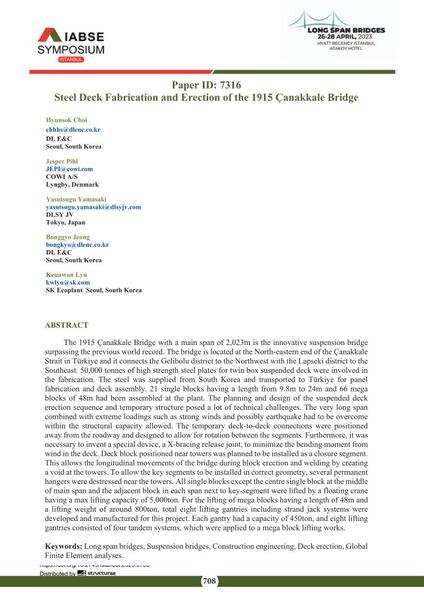Steel Deck Fabrication and Erection of the 1915 Çanakkale Bridge

|
|
|||||||||||
Détails bibliographiques
| Auteur(s): |
Hyunsok Choi
(DL E&C, Seoul, South Korea)
Jesper Pihl (COWI A/S, Lyngby, Denmark) Yasutsugu Yamasaki (, DLSY JVTokyo, Japan) Bonggyo Jeong (DL E&C, Seoul, South Korea) Keunwon Lyu (SK Ecoplant Seoul, South Korea) |
||||
|---|---|---|---|---|---|
| Médium: | papier de conférence | ||||
| Langue(s): | anglais | ||||
| Conférence: | IABSE Symposium: Long Span Bridges, Istanbul, Turkey, 26-28 April 2023 | ||||
| Publié dans: | IABSE Symposium Istanbul 2023 | ||||
|
|||||
| Page(s): | 708-715 | ||||
| Nombre total de pages (du PDF): | 8 | ||||
| Année: | 2023 | ||||
| DOI: | 10.2749/istanbul.2023.0708 | ||||
| Abstrait: |
The 1915 Çanakkale Bridge with a main span of 2,023m is the innovative suspension bridge surpassing the previous world record. The bridge is located at the North-eastern end of the Çanakkale Strait in Türkiye and it connects the Gelibolu district to the Northwest with the Lapseki district to the Southeast. 50,000 tonnes of high strength steel plates for twin box suspended deck were involved in the fabrication. The steel was supplied from South Korea and transported to Türkiye for panel fabrication and deck assembly. 21 single blocks having a length from 9.8m to 24m and 66 mega blocks of 48m had been assembled at the plant. The planning and design of the suspended deck erection sequence and temporary structure posed a lot of technical challenges. The very long span combined with extreme loadings such as strong winds and possibly earthquake had to be overcome within the structural capacity allowed. The temporary deck-to-deck connections were positioned away from the roadway and designed to allow for rotation between the segments. Furthermore, it was necessary to invent a special device, a X-bracing release joint, to minimize the bending moment from wind in the deck. Deck block positioned near towers was planned to be installed as a closure segment. This allows the longitudinal movements of the bridge during block erection and welding by creating a void at the towers. To allow the key segments to be installed in correct geometry, several permanent hangers were destressed near the towers. All single blocks except the centre single block at the middle of main span and the adjacent block in each span next to key-segment were lifted by a floating crane having a max lifting capacity of 5,000ton. For the lifting of mega blocks having a length of 48m and a lifting weight of around 800ton, total eight lifting gantries including strand jack systems were developed and manufactured for this project. Each gantry had a capacity of 450ton, and eight lifting gantries consisted of four tandem systems, which were applied to a mega block lifting works. |
||||
